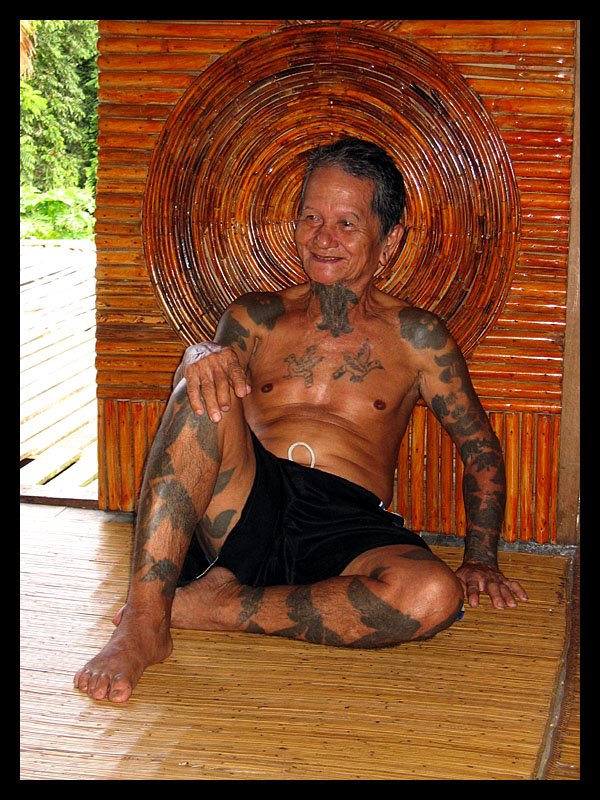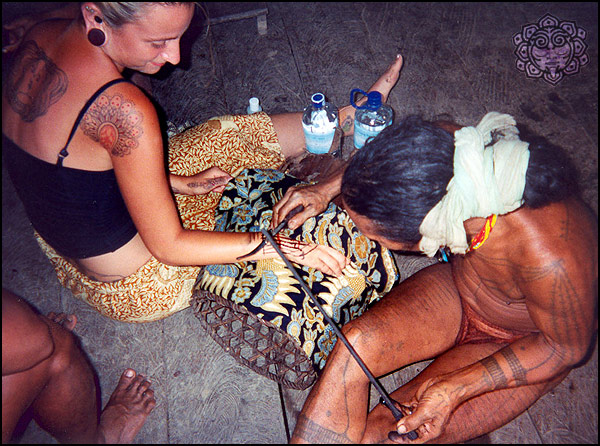WOW !! TATTO TRADISONAL SUKU DAYAK.. NGERI BANGET..!!!
Painted Past: Borneo's Traditional Tattoos
For Borneo's Dayak peoples, spirits embody everything: animals, plants, and
humans, Krutak explained. Many groups have drawn on this power by using images
from nature in their tattoos, creating a composite of floral motifs using
plants with curative or protective powers and powerful animal images.

Tattoos
are created by artists who consult spirit guides to reveal a design. Among
Borneo's Kayan people, women are the artists, a hereditary position passed from
mother to daughter. Among the Iban, the largest and most feared indigenous
group in Borneo, men apply the tattoos.

These
tattoos are blue-black, made of soot or powdered charcoal, substances thought
to ward off malevolent spirits. Some groups spike their pigment with charms—a
ground-up piece of a meteorite or shard of animal bone—to make their tattoos
even more powerful.

For the
outline, the artist attaches up to five bamboo splinters or European needles to
a stick. After dipping them in pigment, he or she taps them into the skin with
a mallet. Solid areas are filled in with a circular configuration of 15 to 20
needles.

Ritual
Tattooing
Traditionally,
Dayak tattooing was performed in a sacred ritual among gathered tribe members.
Among the Ngaju Dayak, Krutak said, the tattoo artist began with a sacrifice to
ancestor spirits, killing a chicken or other fowl and spilling its blood.

After a
period of chanting, the artist started an extremely painful tattooing process
that often lasted six or eight hours. Some tattoos were applied over many
weeks.
For
coming-of-age tattoo rituals, the village men dressed in bark-cloth. This
cloth, made from the paper mulberry tree, also draped corpses and was worn by
widows.
Tattooing,
like other initiation rites, symbolized both a passing away and a new
beginning, a death and a life.

Head-hunting
Tattoos
One Dayak
group, the Iban, believe that the soul inhabits the head. Therefore, taking the
head of one's enemy gives you their soul. Taking the head also conferred your
victim's status, skill and power, which helped ensure farming success and
fertility among the tribe.
Upon
return from a successful head-hunting raid, participants were promptly
recognized with tattoos inked on their fingers, usually images of anthropomorphic
animals.
Head-hunting
was made illegal over a century ago—but even today, an occasional head is still
taken.

Tattooed
Women
In past
times, just as Iban men were tattooed to recognize their prowess in hunting or
warfare, Iban women were adorned for accomplishments in weaving, dancing, or
singing. Adolescent Kayan girls were tattooed at puberty to render status as an
adult, to attract men, and to provide protection against evil spirits.

As they
grew older, women were often covered by a weave of inked images spreading
around their legs, across the tops of their feet, forearms, and fingers.
But only
very wealthy Kayan women sported these intricate tattoos, Krutak
said—"only aristocracy who could pay with a sword, a gong, pigs, or old
trading beads." Only aristocratic women were allowed to use particular
designs, because only these women were powerful enough to resist any negative
magic associated with the designs themselves, he said. Slaves were forbidden to
tattoo.

Marking
Perfection
Tattooing
was done in stages over many years and was governed by various taboos. Once a
Ngaju man had acquired some wealth and reputation, his shoulders were adorned
with a star and his arms decorated with rooster wings and plant patterns.
"But
later in life, perhaps at the age of 40, only 'perfect' men would be allowed to
receive the complete form of Ngaju tattoo," Krutak said. These were men
who had distinguished themselves by living their lives according to ceremonial
law, participating in head-hunting expeditions and the offering of a human
sacrifice—and who had acquired wealth.

This
"complete" tattoo was applied over many days. The man's arms were
covered with images of areca palm fronds that were said to protect him from
malevolent jungle spirits. Then his torso was tattooed with a design of the
Tree of Life, an everlasting symbol of strength and divinity that protected him
from his flesh-and-blood enemies. He was then considered godlike, perfect and
sacred, and it was believed that in the next world he would receive a golden
body.
Among the
Iban, the chests and backs of older, venerated warriors were completely
decorated with a collage of powerful images. The hornbill was a favored motif
because the bird was seen as a messenger of the war god Lang and also marked rank
and prestige. Other favorites were the scorpion and the water serpent, which
protected the wearer from evil spirits lurking in the jungle.
But in
Borneo, and among many other indigenous groups around the globe, this practice
is fading. "Many traditional forms of tattooing are dying out," Keane
said.
source

0 Response to "WOW !! TATTO TRADISONAL SUKU DAYAK.. NGERI BANGET..!!!"
Post a Comment